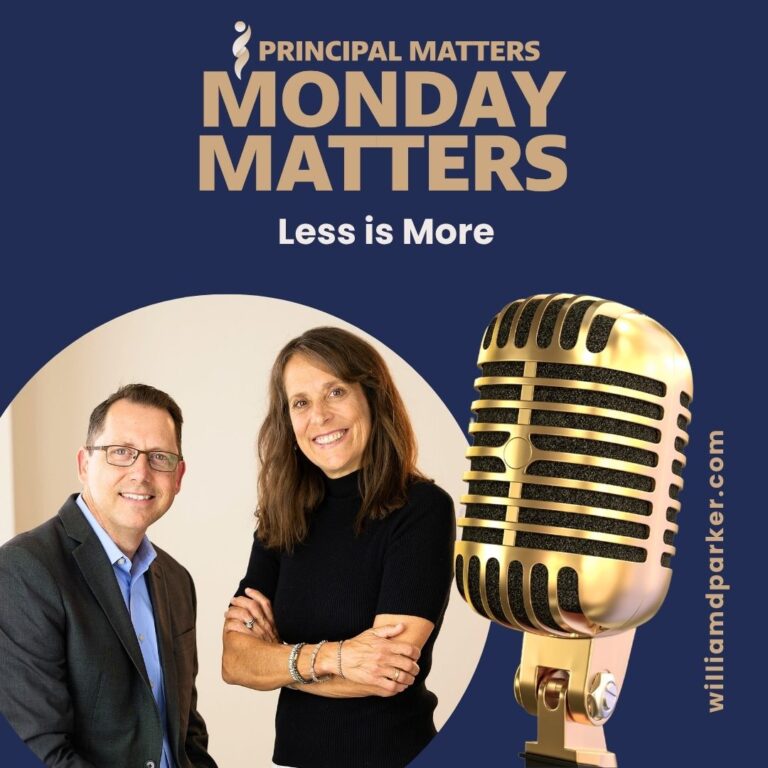Podcast: Play in new window | Download
This summer my wife and I will celebrate our 25th wedding anniversary.

For some reason, I’ve never thought of myself as older, but I realize now that I’m preparing for this anniversary, my children may categorize me that way. My wife, however, will forever be my young bride.
This reminds me of a story: An older married couple is celebrating their wedding anniversary, when the wife turns to the husband and says, “Darling, do you still love me?” And he replies, “Why, yes, I told you that I did 25 years ago.”
As school leaders, we may believe our teachers understand us just because we’ve delivered the message. But understanding is much deeper than simply hearing a message. And messaging with others in your school community requires more than simply relaying information.
Gary Smalley, author of The Five Love Languages, says that relationships are like a bank. To have a healthy “love bank” you must make more deposits than withdrawals.
As you think about your school, how are you strategizing to make sure your positive deposits are outweighing any negative withdrawals? What are some strategies you can use for building a stronger culture of understanding?
This week I am sharing a recent webinar episode on chapter 3 of my book, Messaging Matters: How School Leaders Can Inspire Teachers, Motivate Students, and Reach Communities. In chapters 1 and 2, we focused on mindset and examples for messaging with teachers. Chapter 3 is focus on strategies in four parts:
- Strategies for positive messaging
- Strategies for messaging with technology
- Strategies for meaningful feedback
- Strategies for facilitating change
Here’s a summary of the main points. For explanations and examples, feel free to listen to the podcast or watch the webinar of the presentation:
Part 1: Employ Strategies for Positive Messaging
How do you build a culture that encourage positivity and camaraderie?
- Establish spirit builders
- Introduce and continue traditions
- Organize celebrations
Your culture and relationships are key to any meaningful experience you want others to have in your school.
Part 2: Apply Technology Strategies
If used effectively, technology can enhance the ways you message with teachers throughout a school year.
• Accomplish work and share online
• Use video files to communicate
• Send Friday follow-ups
• Keep these six tech tips in mind…
- Carry an iPhone or camera to capture moments.
- Increase your social media shares.
- Boost a post for more exposure.
- Share weekly summaries of great happenings.
- Use media relationships to promote teacher and student activities.
- Push out press releases beyond your community.
- Communication through technology doesn’t guarantee connection, but if used effectively, it can enhance connection.
Part 3: Practice Strategies for Providing Meaningful Feedback
I bet you value knowing where you are performing well. You also may appreciate it when others help you see blind spots where you may need to pay more attention. Here are some ways to stay pro-active in providing feedback to teachers:
• Be visible
• Attend team meetings
• Invite teachers to leadership lunches
• Attend events and games
• Schedule a one-week observation range
• Make observing the priority
• Give effective feedback
• Divide and delegate
Creating a feedback loop helps you stay tuned in to the needs of your teachers and where they may need more engagement, reflection and action.
Part 4: Apply Strategies for Facilitating Change
Most educators enjoy learning. But even the best educators grow weary of new initiatives or changes. How can you carefully guide others through necessary change?
• Use beta-testing
• Provide steps and tools for change
• Debrief together for feedback
We cannot expect others to remain flexible in an ever-changing environment unless we are strategic in how we introduce and implement change.
Let’s Wrap This Up
Building a strong culture of understanding means being committed to strategies of consistent, positive and meaningful messaging. It means planning ahead and facilitating change with collaboration and strong communication. Just like in love or marriage, we never do this perfectly. But if our positive deposits outweighs our negative withdrawals, we can keep a healthy “love bank” account with our school teams too.
Now It’s Your Turn
Remember you are not in this alone. Who else on your team can you lean on to help broadcast, celebrate and repeat important messages? How can you schedule time in advance so that you can prioritize time in classrooms? How are you anticipating resistance to change and implement processes for feedback and collaboration among teachers?
Sign-Up For Free Updates and Ebook
When you enter your email address below, you will automatically receive my newest posts and a free Ebook, 8 Hats: Essential Roles for School Leaders. Let’s keep learning together!
Subscribe for free weekly updates and receive free e-book!
(function($) {window.fnames = new Array(); window.ftypes = new Array();fnames[0]=’EMAIL’;ftypes[0]=’email’;fnames[1]=’FNAME’;ftypes[1]=’text’;fnames[2]=’LNAME’;ftypes[2]=’text’;}(jQuery));var $mcj = jQuery.noConflict(true);
Principal Matters–The Book!

School leaders are very busy, so each of the twenty-four chapters is designed as a quick-read and followed with take-action questions for follow-up or reflection. If you want practical ideas on understanding your purpose, managing school teams, dealing with challenges, and leading with courage, action, motivation, and teamwork, go HERE to pick up a copy for you or your team.
Messaging Matters

Harness the power of messaging to create a culture of acknowledgment, respect, and celebration. Written specially for leaders, this title is divided into three parts, helping readers to maximize their role as chief communicators with students, teachers, and parents and community. Each chapter includes suggestions for using digital tools to enhance messaging and ends with reflection questions and practical next steps.




